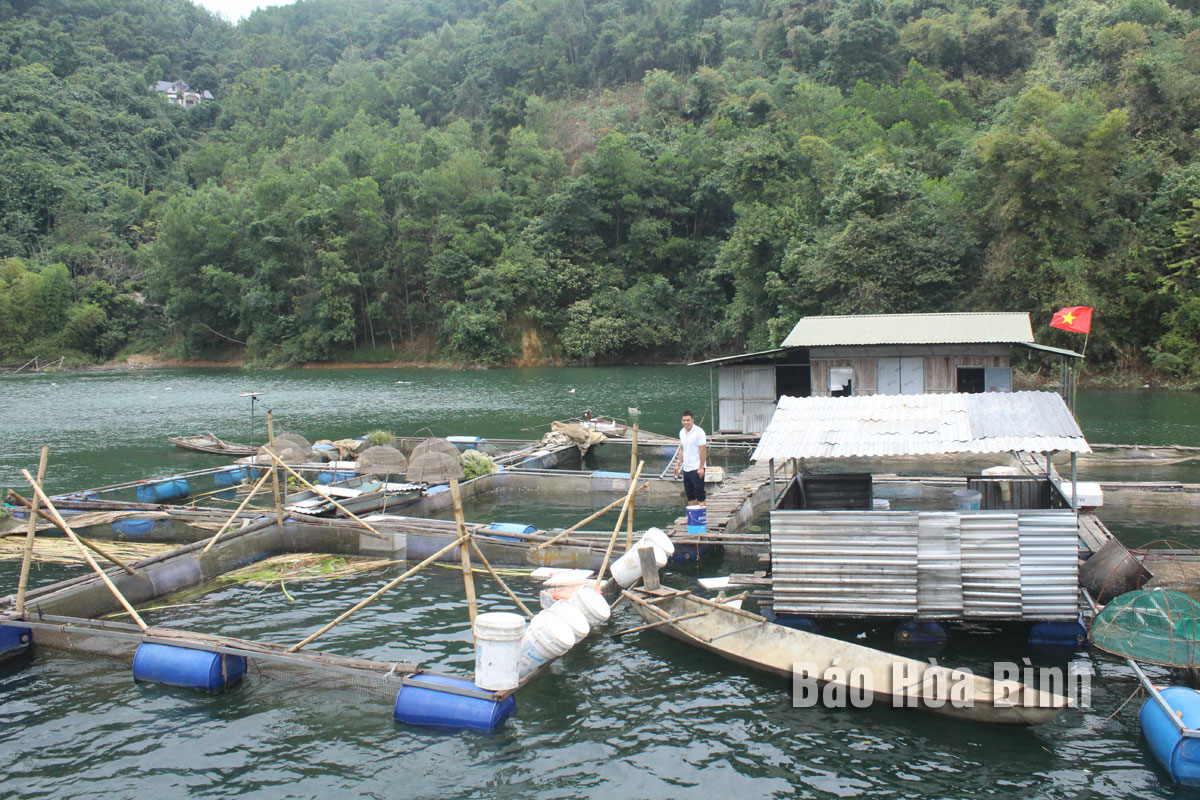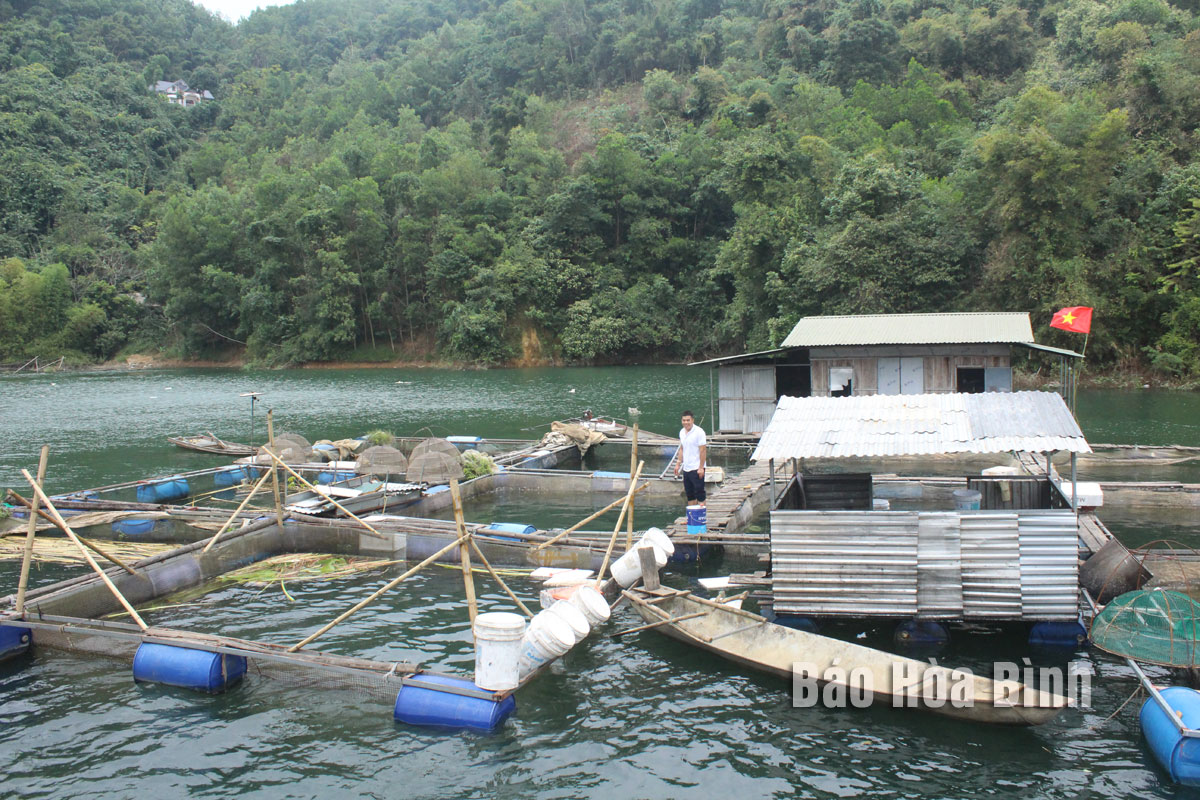
In 2023, fish cage farming has continued to recover after the impact of the COVID-19 pandemic. With advantages in sale, fish cage farming has brought a fair source of income to thousands of households, especially those residing around Hoa Binh reservoir.
This year, fish cage farming on Hoa Binh reservoir develops stably with good consumption.
Tien Phong is one of the communes of Da Bac district where fish cage farming has been developing vigorously. Currently, there are about 800 fish cages with 400 local households engaged in farming. After experiencing many difficulties due to the impact of the COVID-19 pandemic in the two past years (2022 - 2023), fish cage farming households in Tien Phong commune have actively restored production and product consumption. In particular, the establishment of Da Giang Eco Cooperative in the commune has helped promote product supply and consumption linkages.
Xa Ngoc Hung, the cooperative’s director, said it currently has seven official members and 90 affiliated households. When the COVID-19 pandemic was affecting the country, its products were unsold, but the consumption of the fish has been much more favourable over the past two years. At present, farmed fish is sold well, particularly specialty fish such as ca lang (hemibagrus wyckii) are sought after.
To develop fish cage farming stably and sustainably, the cooperative has signed contracts with farming households to purchase fish at market prices, he said.
The cooperative is aiming for intensively processed fish products instead of selling fresh fish as before, he said, adding that this suits the needs of customers and is convenient for transportation, thus improving product values, Hung noted.
In 2023, the Da Giang Eco Cooperative had three products rated as three-star under the One Commune One Product (OCOP) programme, namely Da River black ca lang (hemibagrus wyckii), Da River black ca tram (Ctenopharyngodon idella) and Da River ca nganh (Cranoglanis sinensis).
Da Bac district has 143ha under aquaculture and 2,060 fish cages, concentrating in Hien Luong, Vay Nua and Tien Phong and other communes.
Bui Khac Vinh, Head of the district’s Division of Agriculture and Rural Development, said in 2023, the protection of aquatic resources has been strengthened and the use of electric shock, explosives, and toxic chemicals to exploit aquatic resources has decreased significantly. Fish cage farmers have paid attention to managing the farming environment and implementing measures to prevent farmed fish from diseases. The district has focused on promoting consumption linkages to develop sustainable fish cage farming and bring high economic efficiency.
Hoa Binh province has a fish farming area of 2,695ha with nearly 5,000 cages. It has built trademarks for fish and shrimp of Da River, which have been certified by the Intellectual Property Office of Vietnam. The province has set up three product consumption chains in Hoa Binh city, Da Bac district and Tan Lac - Mai Chau, thereby helping to improve the value of Da River’s fish and shrimp as well as expanding product consumption markets.
Hoang Van Son, Director of the provincial Sub-department of Fisheries, said to develop sustainable aquaculture, in the coming time, the sector will continue to restructure fishery and speed up the application of new technology to fishery activities to diversify products. It will also promote research, transfer and application of scientific and technical advances with priority given to high technology and new advanced scientific and technological solutions.
According to data from the Hoa Binh Provincial Party Committee, the industrial production index for the first six months of 2025 is estimated to have increased by 20% compared to the same period last year. This marks the highest year-on-year growth rate for this period since 2020.
In the first six months of 2025, Hoa Binh province’s export turnover was estimated at 1.145 billion USD, marking an 18.11% increase compared to the same period in 2024. Import turnover was estimated at $ 804 million, a 17.15% increase, which helped the province maintain a positive trade balance.
The lives of the ethnic minority farmers in Tan Lac district have gradually improved thanks to the new directions in agricultural production. This is a testament to the collective strength fostered through the professional associations and groups implemented by various levels of the district’s Farmers’ Union.
With the motto the "product quality comes first,” after nearly one year of establishment and operation, Muong village’s Clean Food Agricultural and Commercial Cooperative, located in Cau Hamlet, Hung Son Commune (Kim Boi district), has launched reputable, high-quality agricultural products to the market that are well-received by consumers. The products such as Muong village’s pork sausage, salt-cured chicken, and salt-cured pork hocks have gradually carved out a place in the market and they are on the path to obtaining the OCOP certification.
In the past, the phrase "bumper harvest, rock-bottom prices" was a familiar refrain for Vietnamese farmers engaged in fragmented, small-scale agriculture. But today, a new spirit is emerging across rural areas of Hoa Binh province - one of collaboration, organisation, and collective economic models that provide a stable foundation for production.
Maintaining growing area codes and packing facility codes in accordance with regulations is a mandatory requirement for agricultural products to be eligible for export. Recently, the Department of Agriculture and Environment of Hoa Binh province has intensified technical supervision of designated farming areas and packing facilities to safeguard the "green passport" that enables its products to access international markets.



